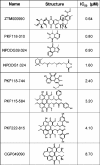The Wnt-dependent signaling pathways as target in oncology drug discovery
- PMID: 16683072
- PMCID: PMC2780666
- DOI: 10.1007/s10637-005-5199-4
The Wnt-dependent signaling pathways as target in oncology drug discovery
Abstract
Our current understanding of the Wnt-dependent signaling pathways is mainly based on studies performed in a number of model organisms including, Xenopus, Drosophila melanogaster, Caenorhabditis elegans and mammals. These studies clearly indicate that the Wnt-dependent signaling pathways are conserved through evolution and control many events during embryonic development. Wnt pathways have been shown to regulate cell proliferation, morphology, motility as well as cell fate. The increasing interest of the scientific community, over the last decade, in the Wnt-dependent signaling pathways is supported by the documented importance of these pathways in a broad range of physiological conditions and disease states. For instance, it has been shown that inappropriate regulation and activation of these pathways is associated with several pathological disorders including cancer, retinopathy, tetra-amelia and bone and cartilage disease such as arthritis. In addition, several components of the Wnt-dependent signaling pathways appear to play important roles in diseases such as Alzheimer's disease, schizophrenia, bipolar disorder and in the emerging field of stem cell research. In this review, we wish to present a focused overview of the function of the Wnt-dependent signaling pathways and their role in oncogenesis and cancer development. We also want to provide information on a selection of potential drug targets within these pathways for oncology drug discovery, and summarize current data on approaches, including the development of small-molecule inhibitors, that have shown relevant effects on the Wnt-dependent signaling pathways.
Figures




References
-
- {'text': '', 'ref_index': 1, 'ids': [{'type': 'PMC', 'value': 'PMC230492', 'is_inner': False, 'url': 'https://pmc.ncbi.nlm.nih.gov/articles/PMC230492/'}, {'type': 'PubMed', 'value': '7739543', 'is_inner': True, 'url': 'https://pubmed.ncbi.nlm.nih.gov/7739543/'}]}
- Du SJ, Purcell SM, Christian JL, McGrew LL, Moon RT: Identification of distinct classes and functional domains of Wnts through expression of wild-type and chimeric proteins in Xenopus embryos. Mol Cell Biol 15:2625–634, 1995 - PMC - PubMed
-
- {'text': '', 'ref_index': 1, 'ids': [{'type': 'PubMed', 'value': '9891778', 'is_inner': True, 'url': 'https://pubmed.ncbi.nlm.nih.gov/9891778/'}]}
- Wodarz A, Nusse R: Mechanisms of Wnt signaling in development. Annual Review of Cell & Developmental Biology 14:59–8, 1998 - PubMed
-
- {'text': '', 'ref_index': 1, 'ids': [{'type': 'PMC', 'value': 'PMC359154', 'is_inner': False, 'url': 'https://pmc.ncbi.nlm.nih.gov/articles/PMC359154/'}, {'type': 'PubMed', 'value': '8065359', 'is_inner': True, 'url': 'https://pubmed.ncbi.nlm.nih.gov/8065359/'}]}
- Wong GT, Gavin BJ, McMahon AP: Differential transformation of mammary epithelial cells by Wnt genes. Mol Cell Biol 14:6278–286, 1994 - PMC - PubMed
-
- {'text': '', 'ref_index': 1, 'ids': [{'type': 'PubMed', 'value': '8144696', 'is_inner': True, 'url': 'https://pubmed.ncbi.nlm.nih.gov/8144696/'}]}
- Moon RT, DeMarais A, Olson DJ: Responses to Wnt signals in vertebrate embryos may involve changes in cell adhesion and cell movement. J Cell Sci Suppl 17:183–88, 1993 - PubMed
-
- {'text': '', 'ref_index': 1, 'ids': [{'type': 'PubMed', 'value': '12137733', 'is_inner': True, 'url': 'https://pubmed.ncbi.nlm.nih.gov/12137733/'}]}
- Kuhl M: Non-canonical Wnt signaling in Xenopus: regulation of axis formation and gastrulation. Semin Cell Dev Biol 13:243–49, 2002 - PubMed
Publication types
MeSH terms
Substances
LinkOut - more resources
Full Text Sources
Other Literature Sources

